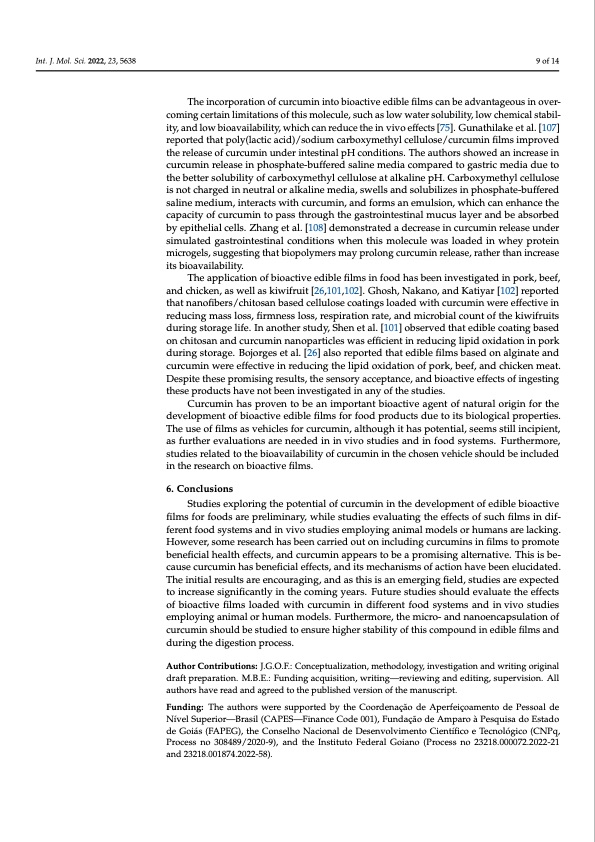
PDF Publication Title:
Text from PDF Page: 009
Int. J. Mol. Sci. 2022, 23, 5638 9 of 14 The incorporation of curcumin into bioactive edible films can be advantageous in over- coming certain limitations of this molecule, such as low water solubility, low chemical stabil- ity, and low bioavailability, which can reduce the in vivo effects [75]. Gunathilake et al. [107] reported that poly(lactic acid)/sodium carboxymethyl cellulose/curcumin films improved the release of curcumin under intestinal pH conditions. The authors showed an increase in curcumin release in phosphate-buffered saline media compared to gastric media due to the better solubility of carboxymethyl cellulose at alkaline pH. Carboxymethyl cellulose is not charged in neutral or alkaline media, swells and solubilizes in phosphate-buffered saline medium, interacts with curcumin, and forms an emulsion, which can enhance the capacity of curcumin to pass through the gastrointestinal mucus layer and be absorbed by epithelial cells. Zhang et al. [108] demonstrated a decrease in curcumin release under simulated gastrointestinal conditions when this molecule was loaded in whey protein microgels, suggesting that biopolymers may prolong curcumin release, rather than increase its bioavailability. The application of bioactive edible films in food has been investigated in pork, beef, and chicken, as well as kiwifruit [26,101,102]. Ghosh, Nakano, and Katiyar [102] reported that nanofibers/chitosan based cellulose coatings loaded with curcumin were effective in reducing mass loss, firmness loss, respiration rate, and microbial count of the kiwifruits during storage life. In another study, Shen et al. [101] observed that edible coating based on chitosan and curcumin nanoparticles was efficient in reducing lipid oxidation in pork during storage. Bojorges et al. [26] also reported that edible films based on alginate and curcumin were effective in reducing the lipid oxidation of pork, beef, and chicken meat. Despite these promising results, the sensory acceptance, and bioactive effects of ingesting these products have not been investigated in any of the studies. Curcumin has proven to be an important bioactive agent of natural origin for the development of bioactive edible films for food products due to its biological properties. The use of films as vehicles for curcumin, although it has potential, seems still incipient, as further evaluations are needed in in vivo studies and in food systems. Furthermore, studies related to the bioavailability of curcumin in the chosen vehicle should be included in the research on bioactive films. 6. Conclusions Studies exploring the potential of curcumin in the development of edible bioactive films for foods are preliminary, while studies evaluating the effects of such films in dif- ferent food systems and in vivo studies employing animal models or humans are lacking. However, some research has been carried out on including curcumins in films to promote beneficial health effects, and curcumin appears to be a promising alternative. This is be- cause curcumin has beneficial effects, and its mechanisms of action have been elucidated. The initial results are encouraging, and as this is an emerging field, studies are expected to increase significantly in the coming years. Future studies should evaluate the effects of bioactive films loaded with curcumin in different food systems and in vivo studies employing animal or human models. Furthermore, the micro- and nanoencapsulation of curcumin should be studied to ensure higher stability of this compound in edible films and during the digestion process. Author Contributions: J.G.O.F.: Conceptualization, methodology, investigation and writing original draft preparation. M.B.E.: Funding acquisition, writing—reviewing and editing, supervision. All authors have read and agreed to the published version of the manuscript. Funding: The authors were supported by the Coordenação de Aperfeiçoamento de Pessoal de Nível Superior—Brasil (CAPES—Finance Code 001), Fundação de Amparo à Pesquisa do Estado de Goiás (FAPEG), the Conselho Nacional de Desenvolvimento Científico e Tecnológico (CNPq, Process no 308489/2020-9), and the Instituto Federal Goiano (Process no 23218.000072.2022-21 and 23218.001874.2022-58).PDF Image | Edible Bioactive Film with Curcumin

PDF Search Title:
Edible Bioactive Film with CurcuminOriginal File Name Searched:
ijms-23-05638.pdfDIY PDF Search: Google It | Yahoo | Bing
CO2 Organic Rankine Cycle Experimenter Platform The supercritical CO2 phase change system is both a heat pump and organic rankine cycle which can be used for those purposes and as a supercritical extractor for advanced subcritical and supercritical extraction technology. Uses include producing nanoparticles, precious metal CO2 extraction, lithium battery recycling, and other applications... More Info
Heat Pumps CO2 ORC Heat Pump System Platform More Info
| CONTACT TEL: 608-238-6001 Email: greg@infinityturbine.com | RSS | AMP |